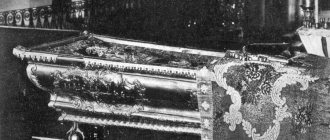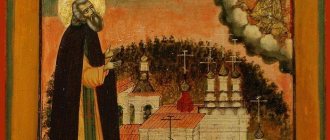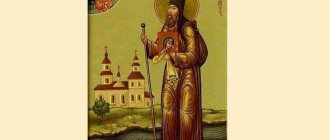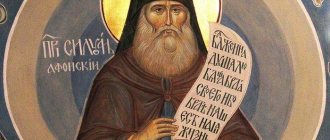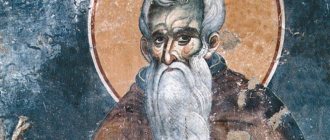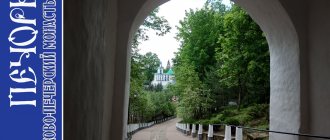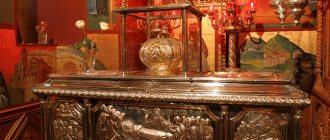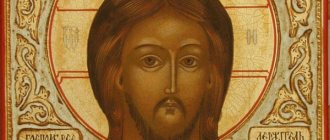On May 20 (May 7, Art. Art.), the memory of one of the strictest ascetics of piety of Ancient Russia is celebrated - the Venerable Nile of Sorsky , the ideological inspirer of the movement of “ non-acquisitives ” who opposed large monastic land ownership and called on the monastics to be guided by the example and way of life of the Athos monks. The Monk Neil became the founder of the monastic hermitage in Rus' and left behind him a few, but very deep in spiritual content - consisting of internal improvement and contemplative prayer - works on the rules of monastic life.
Preliminary information
Nil Sorsky is revered in the Church as a reverend father, one of the founders of monastic asceticism in Rus'.
Not much is known about the early period of the life of St. Nile of Sora. He was born in 1433. According to his own admission, he was a peasant and an ignoramus. This may be due to the fact that his parents were simple villagers.
However, such an assessment could also be voiced by him in connection with the deepest sense of humility. The extensive connections of the saint with many noble people and his high level of education give reason to think that he, nevertheless, had a boyar origin.
His circle of students included: Prince Vassian Kosoy, Dionysius, Nil Polev (who belonged to the family of Smolensk princes) and other famous people.
According to the testimony of one of Nil Sorsky’s contemporaries, in the world he had the nickname Mike.
Reverence
The relics of Saint Nile, buried in the monastery he founded, became famous for many miracles. The Russian Church canonized him as a saint.
In the legends of the Nilosorsky monastery there is a legend that during a visit to the Beloezersky monasteries, Tsar Ivan the Terrible was in the Nilosorsky monastery in 1569 and ordered to found a stone one instead of the wooden church built by the Monk Neil. But, appearing to John in a dream vision, Saint Nile forbade him to do this. In return for the unfulfilled enterprise, the sovereign granted the monastery, with his own signature, a document granting the monastics a monetary salary and bread salary. This certificate has been lost.
Monasticism
The monastic life of Nil Sorsky began in the Kirillo-Belozersk monastery. Here he learned the skills of ascetic life under the guidance of a strict and experienced ascetic, Elder Paisius Yaroslavov. Here he worked, devoted himself to prayer and obedience, vigil and fasting.
After living for some period in the monastery, he, together with his student, monk Innocent (who belonged to the boyar family of Okhlebinins), decided to travel to holy places.
Having reached Athos, he stayed there for quite a long time, adopting the experience of local fathers, growing in spiritual age, studying the rules of desert living, sobriety, and spiritual contemplation.
One of his favorite pastimes was the study of the Holy Scriptures, the life and works of the holy fathers of the Church.
While on the Holy Mountain, Nil Sorsky became accustomed to solitary living, and fell in love with the sacred Christ for the sake of silence.
Returning to Rus', he did not live in the Belozersk monastery, but chose a deserted swampy place nearby, about 15 miles from the monastery, on the Sorka River, erected a cross there, dug a well, founded a cell, a chapel, and indulged in ascetic deeds.
Several brethren gathered around the Monk Nile of Sorsky, seeking salvation. Over time, the number of brothers increased. Through common efforts the church was rebuilt. Construction required considerable effort, because the temple was built on swampy soil. At the place where it was erected, an embankment was previously made.
Life in the monastery was organized on the basis of the rules of monastery residence, borrowed from the Athonite ascetics. This is how the monastic monastery was created.
The life of the brothers was spent in work and prayer, studying the Books of Scripture and the works of the fathers.
The monastic charter implied the hermit life of monks, a complete renunciation of any form of ownership of property and land, and rejection of earthly goods.
Hermits gathered for worship together on Saturdays and holidays. The church services held at the monastery of St. Neil were distinguished by particular severity and completeness. For example, the skete's all-night vigil lasted all night.
The reverend father paid great attention to achieving a high state of grace.
Importance in the education of monks was given to prayerful silence, inner contrition, remembrance of death and the Last Judgment, and struggle with thoughts.
In the fifth chapter of the manual compiled by Nil Sorsky, the Charter, a detailed description is given of how it is necessary to conduct an internal battle against the eight most destructive passionate thoughts (gluttony, fornication, love of money, anger, sadness, despondency, vanity, pride).
In 1491, Nil Sorsky, who by that time had gained fame and respect, participated in the Council that examined the case of the heresy of the Judaizers.
The Judaizing heretics revealed in their teaching one of the most terrible heresies that appeared on the territory of Rus'. They denied the Trinity of God in Persons, the Divine dignity of Christ, and rejected the veneration of holy relics and icons. Despite the apparent obviousness of the new teaching’s contradiction with the Tradition of the Church, this heresy captivated many people, including representatives of the clergy and significant government officials.
Over time, the pockets of this heresy were suppressed by the general efforts of zealous Orthodox defenders.
"Josephites" and "non-covetous" Controversy with St. Joseph Volotsky
Speaking about the life of St. Neil, one should consider in detail the main contradictions and controversial issues of the spiritual life of his era in order to better understand the point of view of the monk and his inner convictions, which were especially clearly manifested during the polemics with his main ideological opponent, St. Joseph, abbot of the Volotsk monastery. At the turn of the 15th-16th centuries, two different directions of religious thought clearly emerged in the Russian Church: the movement of the Josephites and the non-covetous , that is, supporters and opponents of monastic land ownership. The Rev. Nil of Sorsky became the spiritual leader of the non-covetous people; another movement was headed by St. Joseph. There was also a lot of disagreement about the question of acceptable punishments for those found guilty of the “heresy of the Judaizers” - the Josephites strictly insisted on city executions here, but non-possessors were categorically against such methods and considered them unacceptable according to Christian commandments.
At this time, the second wife of the Grand Duke of Moscow Ivan III, Grand Duchess Sophia Palaeologus, the niece of the last Byzantine emperor Constantine 11, had a great influence on both foreign and domestic state policy. She arrived from Rome, where she was forced to move as a child. with her entire family, and Pope Sixtus himself took an active part in her subsequent fate. So, in preparation for the upcoming marriage, along with a portrait of Sophia, he handed over to the Grand Duke a special letter allowing Russian diplomats to freely travel through European countries for a number of years, and allocated a certain amount of money as a dowry. The future empress's cortege, in addition to Russian ambassadors, also included many Italians who later entered Russian service. Residents of Novgorod and Pskov received the solemn delegation very cordially, but the entry into Moscow was marked by a rather unpleasant episode when the Italian Bishop Bonumbra, who accompanied Sophia, was prohibited from importing a Catholic crucifix into the city. Famous Russian historian V.O. Klyuchevsky describes these events as follows:
Ivan was married twice. His first wife was his neighbor's sister, Marya Borisovna. After her death (1467), Ivan began to look for another wife further away and more important. At that time, an orphan lived in Rome, the niece of the last Roman emperor, Sophia Fominichna Paleolog. Despite the fact that the Greeks, since the Union of Florence, had greatly degraded themselves in Russian Orthodox eyes, despite the fact that Sophia lived so close to the hated pope, in such a suspicious church society, Ivan III, overcoming his religious disgust, sent the princess out of Italy and married her in 1472. This princess, then known in Europe for her rare plumpness, brought a very subtle mind to Moscow and acquired very important importance here. The boyars of the 16th century attributed to her all the innovations that were unpleasant to them that had since appeared at the Moscow court [].
Under Sophia, the best Italian craftsmen were summoned to Moscow, who built a new Assumption Cathedral, the Chamber of Facets and a new stone palace on the site of the former wooden mansion. At the same time, a complex and strict ceremony began to be established at the Kremlin, Ivan III for the first time began to call himself “Tsar of All Rus',” and a double-headed eagle appeared on his seals - a symbol of the royal power of the Byzantine emperors. At the same time, a theory appeared about the Divine origin of royal power, the development of which was greatly facilitated by St. Joseph Volotsky. So, for example, he argued that “the king is similar in nature to all people, but in power he is similar to the Most High God.”
Already under Ivan III, and even more so under Vasily, the supreme power surrounded itself with that halo that so sharply separated the Moscow sovereign from the rest of society. The Ambassador of the German Emperor Herberstein, who observed Moscow under Vasily, notes that this Grand Duke finished what his father began, and in his power over his subjects surpasses almost all the monarchs in the world. He adds that in Moscow they say about the Grand Duke: the sovereign’s will is God’s will, the sovereign is the executor of God’s will. When Muscovites are asked about some unknown or dubious matter, they answer with confirmed expressions: we don’t know, God and the great sovereign know. According to Herberstein, they even called their sovereign the housekeeper and bed-keeper of God, applying the language of the Moscow court to such exalted relations. Thus, by the time of Vasiliev’s successor Ivan IV, the code of political concepts with which Muscovite Rus' later lived for so long was ready in Moscow [].
In 1490, the first council was held against the “heresy of the Judaizers”: the Trans-Volga elders Paisius and Nil were invited to Moscow on this occasion. The monk was also present at the council of 1503. Then, in his polemic with St. Joseph of Volotsky, the Monk Nil, argued that monasteries should be freed from the management of estates, that is, inhabited estates. Many monks of Kirillo-Belozersky and some of other monasteries adhered to Nile’s opinion. In his objections, Rev. Joseph put forward mainly the following arguments: “if there are no villages near the monasteries, then how can an honest and noble man get a haircut? If there are no honest elders, how can we appoint a metropolitanate, or an archbishop, or a bishop, and all sorts of honest authorities? And if there are no honest elders and nobles, then there will be a wavering of faith.” And, although the victory remained with the supporters of monastic land ownership, the non-covetous people did not think of giving up their beliefs in the future.
IN. Klyuchevsky, while generally taking a middle position on this issue, gives, however, a rather negative characterization of the monastery owners:
The most prominent opponents of the “Josephites,” as Joseph’s followers were called, were the monastic prince Vassian Patrikeev and the newcomer from Athos Maxim the Greek. Vassian's works are accusatory pamphlets: taking a cue from his teacher Nil Sorsky, with vivid, often truthfully sharp features, he depicts the non-monastic life of patrimonial monasteries, the economic fussiness of the monks, their servility to the strong and rich, selfishness, covetousness and cruel treatment of their peasants... Vassian tends his speech to the same accusations that were later directly expressed by his like-minded Prince Kurbsky: the covetous monks, with their rural management, ruined the peasant lands, and with suggestions about the salvation of investments they made the military rank of the soul, the service landowners worse than the poor. The writings of Maximus the Greek against monastic land ownership are free from polemical excesses. He calmly examines the subject to its essence, although in places he does not do without caustic remarks. By introducing strict communal life in his monastery, Joseph hoped to correct the monastic life and eliminate the contradiction between the monastic renunciation of property and the land wealth of the monasteries by a more dialectical than a practical combination: in the communal life, everything belongs to the monastery and nothing separately belongs to the monks. It’s the same, Maxim objects, as if someone, having joined a gang of robbers and plundered wealth with them, then caught and began to justify himself through torture: I’m not guilty, because everything was left with my comrades, and I didn’t take anything from them. The qualities of a true monk will never be compatible with the attitudes and habits of covetous monasticism: this is the main idea of Maximus the Greek's polemic [].
The primary reasons for the contradictions between supporters and opponents of monastic estates can be seen if you carefully study the initial history of the formation of cenobitic monasteries in Rus'. IN. Klyuchevsky speaks of two types of such monasteries: “deserted” and “secular.” The founders of the “desert” monasteries set out on their feat out of a deep inner calling and, usually, while still young. Having received the appropriate experience in the hostel, they were ready to go into solitude, then the ascetic elders, capable of edification, gathered the young brethren around them and, thus, a new hostel arose. The desert-dwelling monks spent their days in severe labors and prayer, avoiding all excesses and feeding on the labor of their hands.
The “Mir” monasteries had a completely different history. So, for example, a rich boyar or merchant, wanting to have a place in a monastery, where he hoped to pray and do charity with the greatest benefit for the soul during life and rest in death, built a church and cells and gathered the brethren, providing its maintenance with real estate. The ruling prince decorated his capital city with monasteries; sometimes a monastery was built with the assistance of an entire community, urban or rural; it was considered very shameful if a city did not have its own monastery. The monastery was needed by the urban and rural districts so that the average person would have a place to take monastic vows in old age and, upon death, to “settle the soul” with posthumous commemoration. The brothers, who were recruited by builders to such secular monasteries for church services, had the role of hired pilgrims and received a “service” salary from the monastery treasury. People who were looking for peace from worldly worries in their old age in a secular monastery could not follow the strict, active rules of the monastic rule. Ideas of St. Nile of Sorsky were unacceptable here, since such monasteries initially had their own estates, and the inhabitants of precisely such “secular” monasteries already constituted a significant part of the Russian monasticism [].
Venerable Nil of Sorsky. Drawing (translation from the icon). XVI century. Timing belt, PM-4315
Venerable Joseph of Volotsky and Nil of Sorsky
Venerable Nil of Sorsky. Modern icon
Following the council of 1503, the decisions of which mainly concerned monastic estates, a second council was held in December 1504 against the “heresy of the Judaizers.” It was presided over by the eldest son of Princess Sophia, Grand Duke Vasily. The old prince practically did not take part in the activities of the cathedral, and representatives from non-possessors were not invited this time. Compared to 1490, the accused were given a much more severe sentence: St. Joseph, guided by the example of Western Europe and often appealing to the Old Testament, now demanded the most severe punishment, arguing that “the heretic and apostate should not only be condemned, but also cursed, while kings and princes and judges should be sent to prison and subjected to cruel executions.” "[]. Then, in Moscow, Fyodor Kuritsyn’s brother Ivan Volk Kuritsyn, Ivan Maksimov, and Dmitry Pustoselov were burned in specially built wooden log houses. Nekras Rukavov was sent to Novgorod to have his tongue cut, where he was burned along with the Yuriev Archimandrite Kasyan, brother Ivan Samocherny and others. The rest were sent to monasteries.
The executions of heretics caused a mixed reaction in Russian society. Confusion was caused by the discrepancy between the practice of executions and the Gospel, the writings of the holy fathers and canonical norms. Against the arguments presented in the “Enlightener”, the “Response of the Trans-Volga Elders” was compiled, the authorship of which is mainly attributed to the monastic prince Vassian Patrikeev. This letter sounds quite sharp and open, with a direct reproach to the Volotsk abbot:
And you, Mr. Joseph, why don’t you experience your holiness? You would bind Archimandrite Kasyan with your mantle, and until he burned, you would keep him bound in the fire! And we would have accepted you, having emerged from the flame, as one of the three youths! Understand, Mr. Joseph, there is a great difference between Moses, Elijah and the Apostle Peter, the Apostle Paul, and between you and them!
The very struggle against the “heresy of the Judaizers” at that time was closely intertwined with the political struggle for power between two court groups: supporters of John III’s grandson from his first marriage, Demetrius, who had already been married to the Grand Duchy in 1498, and the party of his rival, the future Grand Duke Vasily III , eldest son of Sofia Paleolog. Ultimately, Vasily won, all his main opponents, including Dmitry himself and his mother Elena Voloshanka, were found guilty of heresy and suffered varying degrees of punishment. Ivan III annulled the decision to appoint Dmitry as heir and on April 11, 1502, ordered his daughter-in-law and former heir to be imprisoned. Elena Voloshanka died in prison a “necessary death” (that is, she was killed) in January 1505.
In his dying hour, Grand Duke John felt an inner need to repent before his eldest grandson. The knowledgeable Austrian ambassador Sigismund Herberstein claimed that on the threshold of eternity, the sovereign called Dmitry to himself and said: “Dear grandson, I sinned before God and before you, imprisoning you and depriving you of your rightful inheritance; I conjure you - forgive me the offense; be free, go and exercise your right.” Dmitry, touched by this speech, willingly forgave his grandfather’s guilt. But upon leaving his chambers, he was captured by order of Uncle Gabriel (the future Grand Duke Vasily III) and thrown into prison. Some believe that he died from hunger and cold, others that he was suffocated by smoke. Dmitry the grandson died in 1509 in prison [].
There are a lot of questions and blind spots in the dynastic crisis of the late 15th century, and only very meager information can be gleaned from the available sources. For example, the true reason for the sudden death of Ivan III’s eldest son, Ivan the Young, who was rightfully the legal heir to the Moscow throne, is unknown. He died at the age of 31, after he began taking drugs from a doctor specially prescribed for him from Venice by Grand Duchess Sophia, who was entrusted with curing Ivan of a leg disease. Some researchers believe that it was from the end of the 15th century that the prerequisites for the subsequent split in Rus' became clear. In particular, the Russian publicist G.P. Fedotov wrote that “our holy history ends by the end of the 16th century.”
Theory of St. Joseph of Volotsky about the need to tonsure “honest and noble” people for subsequent elevation to the episcopal see did not find its practical justification in the history of the Russian Church. Just a century and a half after the council of 1503, which finally secured ownership of the monastery estates, all the bishops (except St. Paul of Kolomensky), tonsures of wealthy and prosperous monasteries, were unable to show strength of spirit and gave their consent to innovations detrimental to Rus'. On the other hand, it is known that such luminary fathers of theology as St. Nicholas of Myra, St. Basil the Great, St. John Chrysostom and other holy archpastors of that time, strict ascetics and ascetics, before their accession to the episcopal throne, spent many years in the exploits of strict asceticism and desert living, and they all appeared as firm and uncompromising confessors of the true faith. Throughout the centuries-long history of the fight against heresies in ancient Byzantium, the main stronghold of Orthodoxy was the monastics. But in Rus', only the Solovetsky Monastery and skete ascetics showed open resistance against the church innovations of the 17th century, while other large monasteries did not enter into organized opposition, although it seemed that it was at this decisive moment that true zeal for the purity of faith should have manifested itself. It turned out quite the opposite: many of the most significant monasteries at that time became harsh prisons for confessors of ancient piety. A few more decades later, under Peter I and especially by the decrees of Catherine II in 1764, a complete secularization of church lands was carried out, depriving the deserted New Believer monasteries of all their former privileges.
True monastic life was hidden in the hidden Old Believer hermitages that followed the rules of St. Nil Sorsky. Here, far from the bustle of the world, strict ascetics gathered, courageously risking their very lives for the sake of loyalty to ancient piety. Venerable spoke. Nile:
We will move into the tomb; we have taken nothing of this world, no beauty, no glory, no power, no honor, no other inheritance of life.
The basis of his creations, in contrast to the works of St. Joseph Volotsky, lies the turning of the mind and heart to the future age, where the righteous await an eternal reward and indescribable joy, to which we must strive with all the strength of our souls. He always urged his disciples not to return back to worldly temptations, but to strengthen their thoughts towards eternity, where the real life of a Christian is, the ultimate goal of his earthly wandering:
You yourself know from experience how much sorrow and corruption this passing world has, and how much cruel evil it causes to those who love it, and how it mocks, moving away from those who enslaved it, appearing sweet to them when it caresses their feelings with things, turning out to be bitter later. After all, since people consider his blessings to multiply when they are held back by him, their sorrows increase. And his apparent blessings are apparently good, but inside they are filled with much evil. Therefore, to those who have a truly good mind, the world clearly shows itself - let it not be loved by them.
After the affairs of this life have passed, what happens? Confirm your thought in what I am talking about: what benefit has the world brought to those who hold on to it? Although some had fame, honor, and wealth, did not all this turn into nothing, and pass by like a shadow, and disappear like smoke? And many of them, revolving among the affairs of this world and loving its movement, were reaped by death during their youth and prosperity; as if wildflowers, as soon as they bloomed, fell and were taken away from here against their will. And when they were in this world, they did not understand its stench, but cared about the decoration and peace of the body, inventing methods suitable for obtaining profits in this world, and were trained in what brings crowns to the body in this transitory age. And although they received all this, they did not care about the future and endless bliss, then what should we think about those? Only that in the world there is no crazier than them, as a certain wise saint said [].
Dispute over monastic properties
In 1503, Nil Sorsky was present at the Council, where the issue of monastic property was discussed. Being a supporter of strict monastic life, and preferring monastic life, he resolutely opposed monasteries owning estates and villages.
According to the monk, monks should feed themselves by their own labor and handicrafts. Excessive economic worries associated with the management of material assets distract from ascetic work. In addition to the fact that such concern takes up the energy and time of monastics, it is sometimes associated with concern for profit and covetousness, which contradicts monastic non-covetousness.
The opinion of Nil of Sorsky was supported by the Belozersk hermits present at the Council.
This position of Nil of Sorsky ran counter to the point of view of another saint, St. Joseph of Volotsk, who defended the right of monasteries to own significant land and material property.
The Monk Joseph, being a zealous ascetic, of course understood the importance and necessity of non-covetousness. However, he believed that the acquisition of property by the monastery does not contradict the non-acquisitiveness of the monks working in it.
Unlike Nilus of Sora and his supporters, he emphasized that the possession of property contributes to greater independence of monasteries, including from civil authorities (and, as a consequence, greater independence of the Church).
According to Saint Joseph, the possession of lands and serious material resources opened up the opportunity for the development of monasteries, wider construction of churches, as well as for charity towards the laity.
Joseph's opinion prevailed at the Council. Metropolitan Simon, defending this position before the Grand Duke, resorted not only to the opinion of the Council, but also to the customs of the Greek Church.
Creations
The main books from the spiritual heritage that came to us from the Monk Nile are considered to be “Traditions” and “The Rules of monastic life.”
“The Charter” can be considered the main work of Nil Sorsky. The book consists of 11 chapters and is not a regulation of monastic life, but wise instructions in spiritual struggle. The point of the book is to explain to the monks exactly how they will have to struggle in order to be saved.
Book by Nil Sorsky “On the Mental Warfare in Us”
In particular, the elder gave parting instructions to the monks on how to resist prodigal passions and how to strengthen themselves to accomplish spiritual deeds. Many people who eagerly begin spiritual warfare quickly burn out and give up.
The ascetic teaches how to maintain strength for this struggle throughout life. Separate chapters of the book are devoted to the fight against various passionate thoughts. In his work, the righteous man also speaks in detail about the Last Judgment, about caring for the true.
In “Traditions” a lot of attention is paid to the description of monastic life, attitude towards material wealth, and communication with people from the world. In addition, the elder also gave soul-helping advice on counteracting lustful thoughts.
The main provisions of the “Tradition”:
- According to the elder’s teachings, the monks had to earn food by their own labor.
- Hermits were supposed to accept alms only in cases of serious illness and extreme need.
- Church life should have been organized simply, without frills. There should have been no items made of precious metals in the church.
- Women are strictly prohibited from visiting the monastery skete.
- The main principle of monastic life was complete non-covetousness; none of the monks had their own personal belongings.
Blessed death
Before his death, Saint Nil of Sora gave his last instructions to the brethren.
Regarding his future funeral, he said that he was not worthy of an honorable burial, as a sinner, he called on his disciples to throw his body in the desert, to be devoured by wild beasts, or to bury it with contempt in a hole. At the same time, he added that just as he tried not to use honor on earth, in this life, so he would like it to be the same after his death.
On May 7, 1508, the saint peacefully departed to God. The holy relics are in his desert, hidden.
The treatises of the holy fathers have been rewritten beyond recognition!
The young elder who returned from Athos was full of inspiration to organize monastic hostels in Rus': instead of crowded monasteries, build ascetic monasteries for two or three people (first on the Sora River, and then beyond the Volga). Nile also wants to collect a spiritual library in Rus', similar to the one at Athos.
Reading the Slavic translations of the holy books, Neil is horrified: four centuries after Vladimirov’s baptism, the treatises of the holy fathers were rewritten beyond recognition! So many lies and false images! How easily it can be reversed!
The original fathers have not a word of evil. Only merciful love, patience, lamb's peace, mental prayer. In the rewritten books there is an emphasis on Old Testament Jaldabaothism. Direct succession from the rabbis!
Neil begins reform. Gathers the brethren, organizes many hermitages. He revises books himself. He has to rewrite dozens of treatises of the holy fathers, freeing them from additions.
Troparion to St. Nil of Sorsky, tone 4
Having fled, like David, the world, / and all that is in it, as if it were thought, / and, in a silent place, / you were filled with spiritual joy, our Father Nile, / and, to one Having deigned to serve God,/ you have prospered, like a phoenix,/ and like a fruitful vine,/ you have multiplied the children of the desert./ Thus we cry out with gratitude:/ glory to Him who strengthened you in the feat of living in the desert;/ glory to Him who chose you to depart in Russia The nickname of the charterer is quite numerous; // glory through your prayers to Him who Saviors us.
Kontakion to St. Nile of Soror, tone 8
For the love of Christ, having escaped from worldly troubles,/ you lived in the desert with a joyful soul,/ you labored well in it,/ like an Angel on earth, Father Nile, you lived:/ in vigil. and afterward you exhausted your body eternally for the sake of life./ Having now become worthy of it ,/ in the light of the ineffable joy of the Most Holy Trinity standing with the saints,/ pray, pray, falling down, your children,/ that we may be preserved from all slander and evil circumstances/ visible and invisible enemies// and save our souls.
Kontakion to St. Nil of Sorsky, tone 3
Having endured, you have endured the vain customs / and worldly morals of your brothers, / you have found deserted silence, like a Father, / where we fast, vigil and unceasing prayer in labor You have labored,/ through your teachings you have shown us the right paths/ to walk to the Lord.// Also and we honor you, all-blessed Nile.
Prayer
About the reverend and God-blessed Father Nile, our God-wise mentor and teacher! For the love of God, you removed yourself from worldly troubles, in the impassable desert and in the wilds you deigned to dwell, and like a fruitful vine, you multiplied the children of the desert, in word, writing and life. The image of all monastic virtues appeared; and like an angel in the flesh, having lived on earth, now in the villages of Heaven, where they celebrate the unceasing voice, he dwells, and stands before God from the faces of the saints, to Him you continually bring praise and praise . We pray to you, O blessed God, instruct us, who live under your roof, to walk unfailingly in your footsteps and to love the Lord God with all our hearts, to lust for Him alone and for Him alone. think, courageously and skilfully fight against the enticing thoughts and tactics of the enemy always win; Let us love all the crampedness of the monastic life and help us to hate the redness of this world, for the love of Christ; Help us to plant every virtue that you yourself have labored for in our hearts. Pray to Christ God, and for all Orthodox Christians living in the world, to enlighten the mind and eyes of the heart, leading to salvation, to confirm me in faith and piety and in keeping His commandments, and to keep me from hell the blessings of this world, and the remission of sins is granted to all Christians, He will also add everything needed for temporary life to everyone. Yes, all Christians, living in the desert and in the world, will live a quiet and silent life in all piety and honesty, and will glorify Christ with their lips and hearts, together with His beginningless Father. by His Most Holy and Good and Life-giving Spirit, always, now and ever and forever and ever. Amen.
